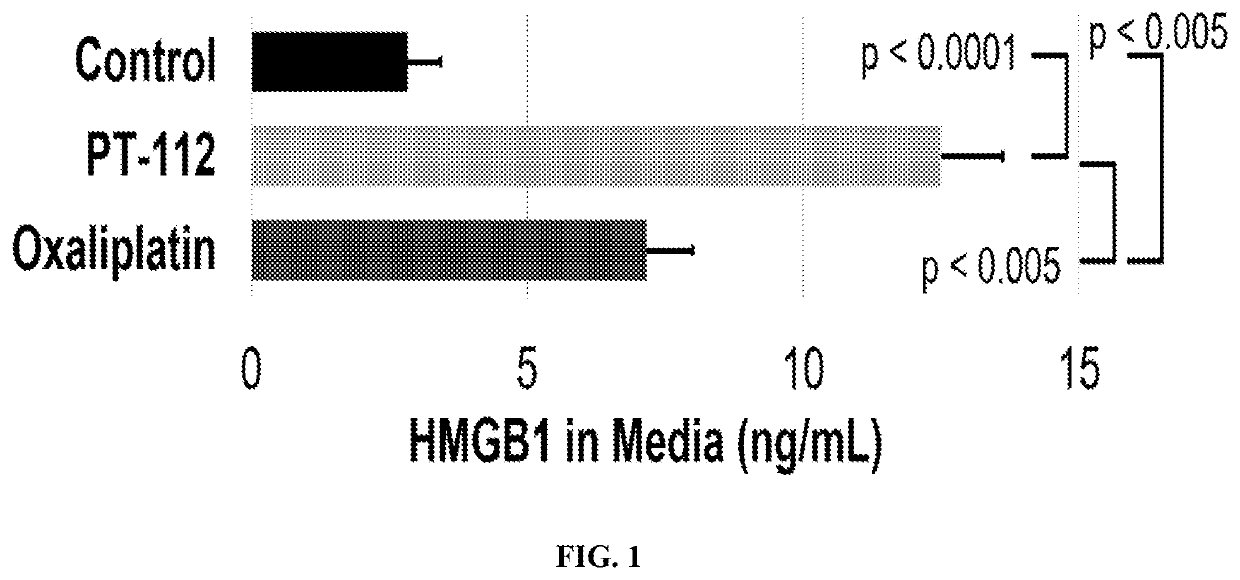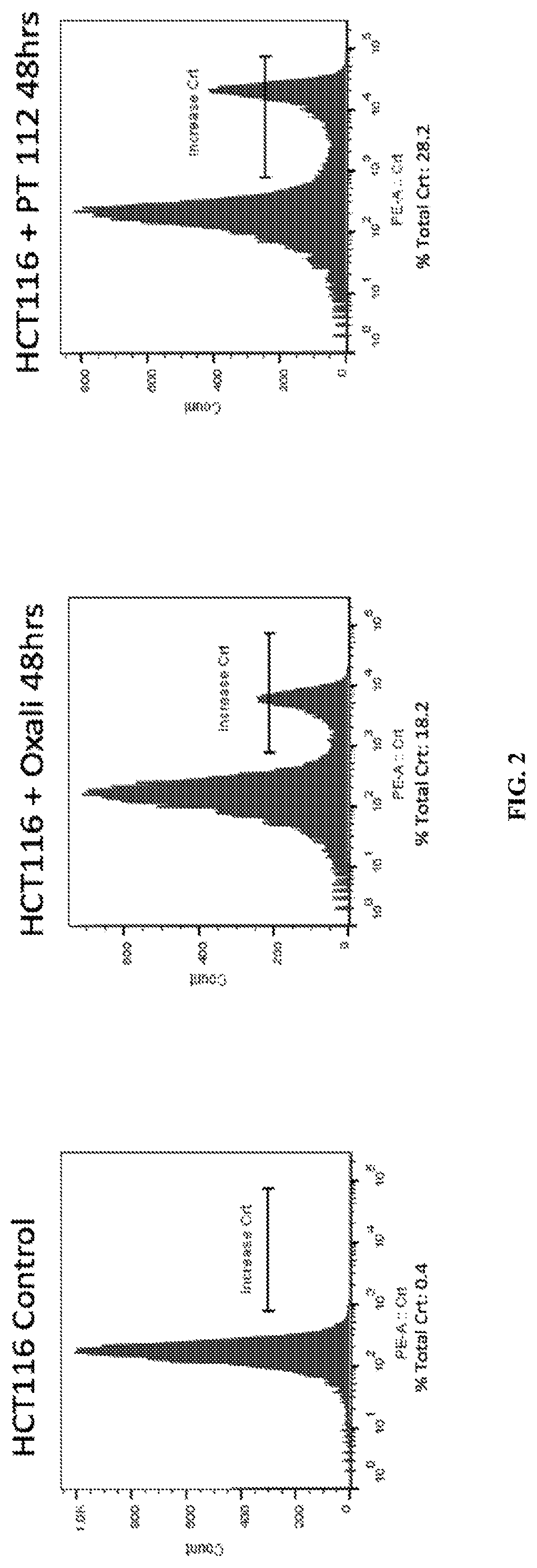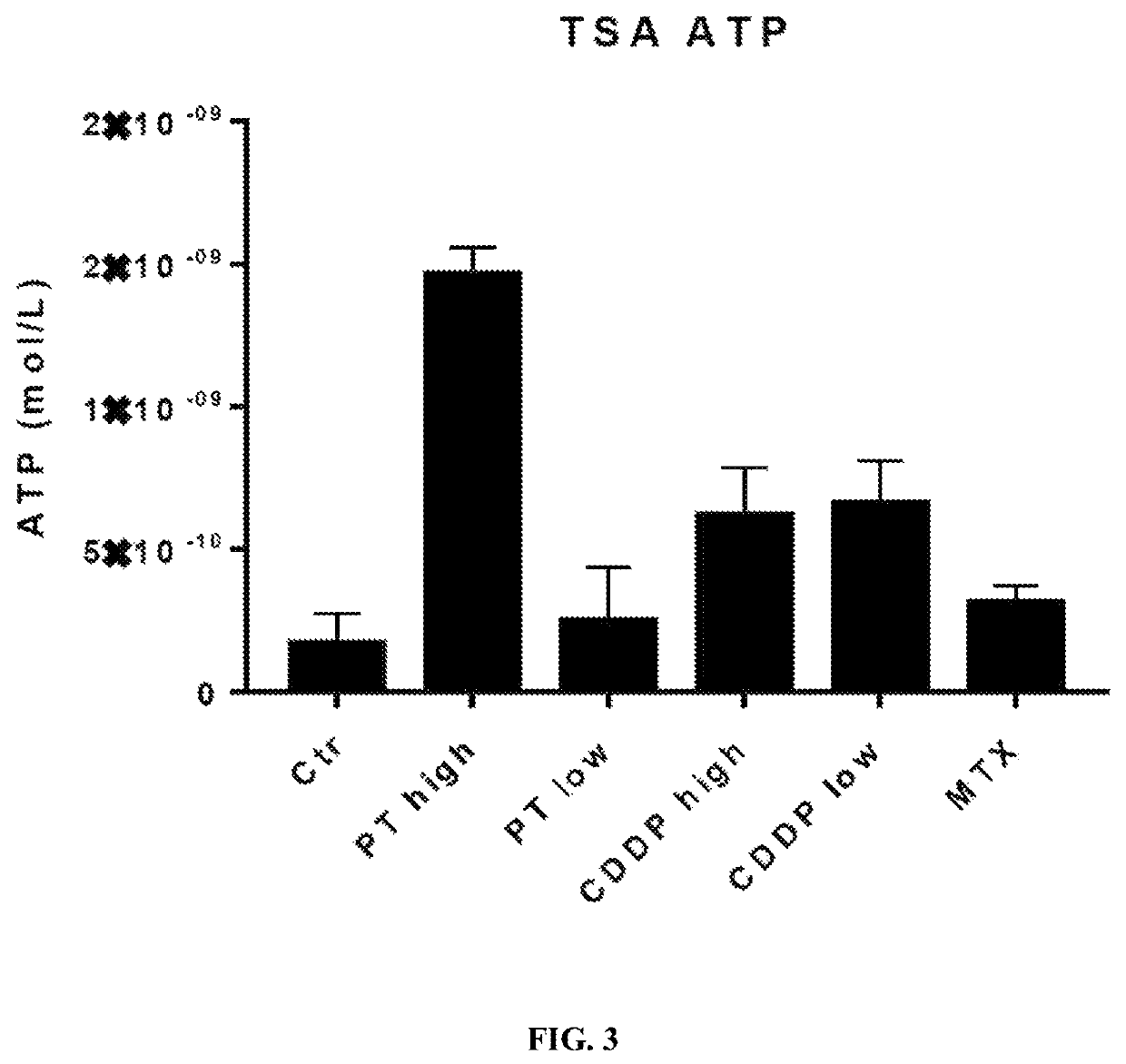Phosphaplatin compounds as immuno-modulatory agents and therapeutic uses thereof
a technology of phosphaplatin and compounds, applied in the direction of antibody medical ingredients, drug compositions, vertebrate antigen ingredients, etc., can solve the problems of transcriptional interference and apoptosis, not without their problems, and substantial toxicities involving several organs and body systems
- Summary
- Abstract
- Description
- Claims
- Application Information
AI Technical Summary
Benefits of technology
Problems solved by technology
Method used
Image
Examples
example 1
PT-112 Induces Immunogenic Cell Death (ICD)
[0085]While apoptosis is frequently tolerogenic or nonimmunogenic, certain agents can induce a form of apoptosis in cancer cells called ICD. When cancer cells are killed via exposure to ICD-inducing agents, they release Damage Associated Molecular Patterns (DAMPs). These molecules serve to alert the immune system to the presence of cancer cells via the activation of dendritic cells and, subsequently, cytotoxic T cells. For a comprehensive review, see Kroemer et al., 2013 Annu. Rev. Immunol. 31:51-72.
[0086]Two such DAMPs are high mobility group box 1 (HMGB1) and calreticulin (CRT). HMGB1 is released from dying cells during ICD, whereas CRT migrates from the endoplasmic reticulum to the cell surface during ICD. To test if PT-112 exposure results in these events that are considered hallmarks of ICD, in vitro experiments using the HCT116 colorectal cancer cell line were conducted. In both cases, oxaliplatin was used as a positive control, as it...
example 2
Test of PT-112 Immunomodulation, and Synergy in Combination with a PD-1 CPI, in a Mouse Allograft Experiment
[0094]In a mouse allograft experiment, immuno-competent mice were implanted with CT26 mouse colon cancer cells (FIG. 5). Mice were subsequently randomized into groups (n=7) and treatment was initiated on Day 1 with 90 mg / kg PT-112 IV administered once a week for a total of 6 doses, on Day 2 with 10 mg / kg anti-PD-1 antibody administered twice a week for a total of 6 doses, or the combination of the two. Additionally, control animals were dosed with vehicle. Tumor volumes were monitored during and post treatment.
[0095]Results showed that treatment with PT-112 was more effective than treatment with anti-PD-1 antibody alone (54% TGI for PT-112 compared with 19% TGI for anti-PD-1 antibody), but combination therapy with PT-112 and anti-PD-1 antibody was dramatically more effective than either agent alone (83% TGI for the combination of PT-112+ anti-PD-1 antibody). Cures were observe...
example 3
Test of PT-112 Immunomodulation, and Synergy in Combination with a PD-L1 CPI, in a Further Mouse Allograft Experiment
[0098]Positive efficacy results using a combination of PT-112 and an anti-PD-L1 antibody in the MC38 murine cancer model were observed, similar to those described in Example 2 (data not shown). To better understand the effects of the different treatments on T cell populations, additional immuno-competent mice were implanted with MC38 cells and were subsequently randomized into control, PT-112, anti-PD-L1 antibody, or combination treatment arms (n=5). After 2 weeks of treatment (PT-112 @ 90 mg / kg QW and PD-L1 @ 10 mg / kg BIW), tumor tissue was removed and analyzed via FACS for differences in white blood cell populations. Treatment with the anti-PD-L1 antibody did not result in substantial changes in any of the measured cell populations, whereas treatment with PT-112 caused large changes in various cell populations, including cytotoxic T cells (CD8+) and helper T cells (...
PUM
| Property | Measurement | Unit |
|---|---|---|
| body weight | aaaaa | aaaaa |
| weight | aaaaa | aaaaa |
| structure | aaaaa | aaaaa |
Abstract
Description
Claims
Application Information
 Login to View More
Login to View More - R&D
- Intellectual Property
- Life Sciences
- Materials
- Tech Scout
- Unparalleled Data Quality
- Higher Quality Content
- 60% Fewer Hallucinations
Browse by: Latest US Patents, China's latest patents, Technical Efficacy Thesaurus, Application Domain, Technology Topic, Popular Technical Reports.
© 2025 PatSnap. All rights reserved.Legal|Privacy policy|Modern Slavery Act Transparency Statement|Sitemap|About US| Contact US: help@patsnap.com



